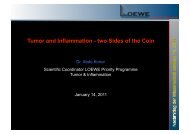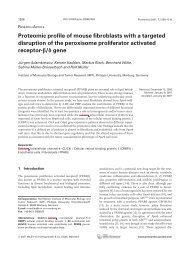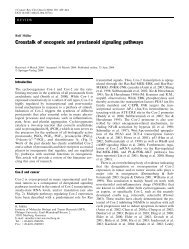Alexander Brehm - Biochemical characterization of Drosophila ... - IMT
Alexander Brehm - Biochemical characterization of Drosophila ... - IMT
Alexander Brehm - Biochemical characterization of Drosophila ... - IMT
You also want an ePaper? Increase the reach of your titles
YUMPU automatically turns print PDFs into web optimized ePapers that Google loves.
<strong>Alexander</strong> <strong>Brehm</strong> - <strong>Biochemical</strong> <strong>characterization</strong> <strong>of</strong> <strong>Drosophila</strong> L(3)MBT<br />
Background<br />
Mutation <strong>of</strong> the lethal (3) malignant brain tumour (l(3)mbt) gene in D.melanogaster<br />
causes the transformation <strong>of</strong> cells <strong>of</strong> the larval brain and the overgrowth <strong>of</strong> imaginal<br />
discs suggesting that it is involved in cell cycle control (Gateff et al., 1993; Wismar et<br />
al., 1995). In addition, l(3)mbt is required for germ cell formation (Yohn et al., 2003).<br />
Together with Sfmbt and Scm, l(3)mbt forms a family <strong>of</strong> three genes coding for<br />
proteins containing MBT domains. Some MBT domains have recently been shown to<br />
recognize differentially methylated histone tails and have been suggested to<br />
participate in chromatin compaction (Francis et al., 2004; Klymenko et al., 2006;<br />
Trojer et al., 2007). Sfmbt binds to histone H3 tails mono- or dimethylated at K9<br />
(H3K9me1 and H3K9me2) and H4 tails mono- or dimethylated at K20<br />
(H4K20me1/2) (Klymenko et al., 2006). The human MBT protein L3MBTL1<br />
recognizes mono- and dimethylated histones H4 and H1 (H4K20me1/2,<br />
H1bK26me1/2) (Trojer et al., 2007).<br />
Several MBT domain containing proteins are subunits <strong>of</strong> multisubunit protein<br />
complexes regulating chromatin structure that control gene expression during<br />
development (Klymenko et al., 2006; Saurin et al., 2001). Sfmbt is a subunit <strong>of</strong><br />
PhoRC, a Polycomb group (PcG) complex, Scm is a component <strong>of</strong> distinct PcG<br />
complex, PRC1. Both complexes function to maintain tissue specific repression <strong>of</strong><br />
genes throughout D.melanogaster development. L3MBTL1 is part <strong>of</strong> a complex<br />
containing histone H1b, HP1 proteins and pRb and is involved in the regulation <strong>of</strong><br />
E2F target genes (Trojer et al., 2007).<br />
It is unclear if D.melanogaster L(3)MBT also functions within multisubunit<br />
chromatin regulating complexes and if it recognizes methylated histone tails.<br />
L(3)MBT has been reported to be a substoichiometric member <strong>of</strong> the Myb-MuvB<br />
complex and to be required for the repression <strong>of</strong> some Myb-MuvB target genes<br />
(Lewis et al., 2004). However, independent purification <strong>of</strong> the same complex did not<br />
result in the detection <strong>of</strong> L(3)MBT (Korenjak et al., 2004).<br />
Aims<br />
In this project we wish to biochemically characterize the D.melanogaster L(3)MBT<br />
protein. We will establish D.melanogaster cell lines expressing epitope tagged<br />
L(3)MBT und affinity purify L(3)MBT associated proteins from extracts <strong>of</strong> these<br />
cells. L(3)MBT interacting proteins will be identified by mass spec analysis and<br />
interactions will be confirmed in vivo and in vitro.<br />
We will characterise antibodies raised against L(3)MBT-derived peptides and use<br />
these antibodies to determine L(3)MBT expression in embryos and to perform<br />
coimmunoprecipitation and chromatinimmunoprecipitation experiments.<br />
In order to identify genes regulated by L(3)MBT we will RNAi-deplete L(3)MBT<br />
from cells and assay changes in gene expression pr<strong>of</strong>iles using microarray<br />
technology.
Finally, we will employ in vitro peptide binding assays to identify histone tail<br />
modifications recognized by the MBT domains <strong>of</strong> L(3)MBT.<br />
Cited literature illustrating background<br />
Francis, N. J., Kingston, R. E., and Woodcock, C. L. (2004). Chromatin compaction by a polycomb<br />
group protein complex. Science 306, 1574-1577.<br />
Gateff, E., L<strong>of</strong>fler, T., and Wismar, J. (1993). A temperature-sensitive brain tumor suppressor mutation<br />
<strong>of</strong> <strong>Drosophila</strong> melanogaster: developmental studies and molecular localization <strong>of</strong> the gene. Mech Dev<br />
41, 15-31.<br />
Klymenko, T., Papp, B., Fischle, W., Kocher, T., Schelder, M., Fritsch, C., Wild, B., Wilm, M., and<br />
Muller, J. (2006). A Polycomb group protein complex with sequence-specific DNA-binding and<br />
selective methyl-lysine-binding activities. Genes Dev 20, 1110-1122.<br />
Korenjak, M., Taylor-Harding, B., Binne, U. K., Satterlee, J. S., Stevaux, O., Aasland, R., White-<br />
Cooper, H., Dyson, N., and <strong>Brehm</strong>, A. (2004). Native E2F/RBF complexes contain Myb-interacting<br />
proteins and repress transcription <strong>of</strong> developmentally controlled E2F target genes. Cell 119, 181-193.<br />
Lewis, P. W., Beall, E. L., Fleischer, T. C., Georlette, D., Link, A. J., and Botchan, M. R. (2004).<br />
Identification <strong>of</strong> a <strong>Drosophila</strong> Myb-E2F2/RBF transcriptional repressor complex. Genes Dev 18, 2929-<br />
2940.<br />
Saurin, A. J., Shao, Z., Erdjument-Bromage, H., Tempst, P., and Kingston, R. E. (2001). A <strong>Drosophila</strong><br />
Polycomb group complex includes Zeste and dTAFII proteins. Nature 412, 655-660.<br />
Trojer, P., Li, G., Sims, R. J., 3rd, Vaquero, A., Kalakonda, N., Boccuni, P., Lee, D., Erdjument-<br />
Bromage, H., Tempst, P., Nimer, S. D., et al. (2007). L3MBTL1, a Histone-Methylation-Dependent<br />
Chromatin Lock. Cell 129, 915-928.<br />
Wismar, J., L<strong>of</strong>fler, T., Habtemichael, N., Vef, O., Geissen, M., Zirwes, R., Altmeyer, W., Sass, H.,<br />
and Gateff, E. (1995). The <strong>Drosophila</strong> melanogaster tumor suppressor gene lethal(3)malignant brain<br />
tumor encodes a proline-rich protein with a novel zinc finger. Mech Dev 53, 141-154.<br />
Yohn, C. B., Pusateri, L., Barbosa, V., and Lehmann, R. (2003). l(3)malignant brain tumor and three<br />
novel genes are required for <strong>Drosophila</strong> germ-cell formation. Genetics 165, 1889-1900.<br />
Own publications<br />
Schmit F., Korenjak M., Mannefeld M., Schmitt K., Franke C., von Eyss B., Gagrica S., Hänel F.,<br />
<strong>Brehm</strong> A. and Gaubatz S. (2007) LINC, a human complex that is related to pRB-containing<br />
complexes in invertebrates regulates the expression <strong>of</strong> G2/M genes. Cell Cycle, in press.<br />
Korenjak M. and <strong>Brehm</strong> A. (2006) The retinoblastoma tumour suppressor in model organisms--new<br />
insights from flies and worms. Curr Mol Med., 6, 705-711.<br />
Bouazoune K. and <strong>Brehm</strong> A. (2006) ATP-dependent chromatin remodeling complexes in <strong>Drosophila</strong><br />
Chromosome Research, 14, 433-449.<br />
Bouazoune K. and <strong>Brehm</strong> A. (2005) dMi-2 chromatin binding and remodeling activities are regulated<br />
by dCK2 phosphorylation, J. Biol. Chem., 280, 41912-41920.<br />
Bouazoune, K., Korenjak, M. and <strong>Brehm</strong>, A. (2004) The dosage-compensation complex in flies and<br />
humans. Genome Biol, 5, 352.<br />
Korenjak, M., Taylor-Harding, B., Binne, U.K., Satterlee, J.S., Stevaux, O., Aasland, R., White-<br />
Cooper, H., Dyson, N. and <strong>Brehm</strong>, A. (2004) Native E2F/RBF complexes contain Mybinteracting<br />
proteins and repress transcription <strong>of</strong> developmentally controlled E2F target genes.<br />
Cell, 119, 181-193.<br />
Taylor-Harding, B., Binne, U.K., Korenjak, M., <strong>Brehm</strong>, A. and Dyson, N.J. (2004) p55, the <strong>Drosophila</strong><br />
ortholog <strong>of</strong> RbAp46/RbAp48, is required for the repression <strong>of</strong> dE2F2/RBF-regulated genes.<br />
Mol Cell Biol, 24, 9124-9136.<br />
Marhold, J., <strong>Brehm</strong>, A. and Kramer, K. (2004) The <strong>Drosophila</strong> methyl-DNA binding protein MBD2/3<br />
interacts with the NuRD complex via p55 and MI-2. BMC Mol Biol, 5, 20.<br />
<strong>Brehm</strong>, A., Tufteland, K.R., Aasland, R. and Becker, P.B. (2004) The many colours <strong>of</strong><br />
chromodomains. Bioessays, 26, 133-140.<br />
Sutcliffe, J.E. and <strong>Brehm</strong>, A. (2004) Of flies and men; p53, a tumour suppressor. FEBS Lett, 567, 86-<br />
91.
Sutcliffe, J.E., Korenjak, M. and <strong>Brehm</strong>, A. (2003) Tumour suppressors--a fly's perspective. Eur J<br />
Cancer, 39, 1355-1362.<br />
Bouazoune, K., Mitterweger, A., Langst, G., Imh<strong>of</strong>, A., Akhtar, A., Becker, P.B. and <strong>Brehm</strong>, A. (2002)<br />
The dMi-2 chromodomains are DNA binding modules important for ATP- dependent<br />
nucleosome mobilization. Embo J, 21, 2430-2440.<br />
Czermin, B., Schotta, G., Hulsmann, B.B., <strong>Brehm</strong>, A., Becker, P.B., Reuter, G. and Imh<strong>of</strong>, A. (2001)<br />
Physical and functional association <strong>of</strong> SU(VAR)3-9 and HDAC1 in <strong>Drosophila</strong>. EMBO Rep,<br />
2, 915-919.<br />
Murawsky, C.M., <strong>Brehm</strong>, A., Badenhorst, P., Lowe, N., Becker, P.B. and Travers, A.A. (2001)<br />
Tramtrack69 interacts with the dMi-2 subunit <strong>of</strong> the <strong>Drosophila</strong> NuRD chromatin remodelling<br />
complex. EMBO Rep, 2, 1089-1094.<br />
Yang, S.H., Vickers, E., <strong>Brehm</strong>, A., Kouzarides, T. and Sharrocks, A.D. (2001) Temporal recruitment<br />
<strong>of</strong> the mSin3A-histone deacetylase corepressor complex to the ETS domain transcription<br />
factor Elk-1. Mol Cell Biol, 21, 2802-2814.<br />
<strong>Brehm</strong>, A., Langst, G., Kehle, J., Clapier, C.R., Imh<strong>of</strong>, A., Eberharter, A., Muller, J. and Becker, P.B.<br />
(2000) dMi-2 and ISWI chromatin remodelling factors have distinct nucleosome binding and<br />
mobilization properties. Embo J, 19, 4332-4341.<br />
Fuks, F., Burgers, W.A., <strong>Brehm</strong>, A., Hughes-Davies, L. and Kouzarides, T. (2000) DNA<br />
methyltransferase Dnmt1 associates with histone deacetylase activity. Nat Genet, 24, 88-91.<br />
Lutz, M., Burke, L.J., Barreto, G., Goeman, F., Greb, H., Arnold, R., Schultheiss, H., <strong>Brehm</strong>, A.,<br />
Kouzarides, T., Lobanenkov, V. and Renkawitz, R. (2000) Transcriptional repression by the<br />
insulator protein CTCF involves histone deacetylases. Nucleic Acids Res, 28, 1707-1713.<br />
Martinez-Balbas, M.A., Bauer, U.M., Nielsen, S.J., <strong>Brehm</strong>, A. and Kouzarides, T. (2000) Regulation <strong>of</strong><br />
E2F1 activity by acetylation. Embo J, 19, 662-671.<br />
<strong>Brehm</strong>, A. and Kouzarides, T. (1999) Retinoblastoma protein meets chromatin. Trends Biochem Sci,<br />
24, 142-145.<br />
<strong>Brehm</strong>, A., Miska, E., Reid, J., Bannister, A. and Kouzarides, T. (1999a) The cell cycle-regulating<br />
transcription factors E2F-RB. Br J Cancer, 80 Suppl 1, 38-41.<br />
<strong>Brehm</strong>, A., Nielsen, S.J., Miska, E.A., McCance, D.J., Reid, J.L., Bannister, A.J. and Kouzarides, T.<br />
(1999b) The E7 oncoprotein associates with Mi2 and histone deacetylase activity to promote<br />
cell growth. Embo J, 18, 2449-2458.<br />
<strong>Brehm</strong>, A., Ohbo, K., Zwerschke, W., Botquin, V., Jansen-Durr, P. and Scholer, H.R. (1999c)<br />
Synergism with germ line transcription factor Oct-4: viral oncoproteins share the ability to<br />
mimic a stem cell-specific activity. Mol Cell Biol, 19, 2635-2643.<br />
Radkov, S.A., Touitou, R., <strong>Brehm</strong>, A., Rowe, M., West, M., Kouzarides, T. and Allday, M.J. (1999)<br />
Epstein-Barr virus nuclear antigen 3C interacts with histone deacetylase to repress<br />
transcription. J Virol, 73, 5688-5697.


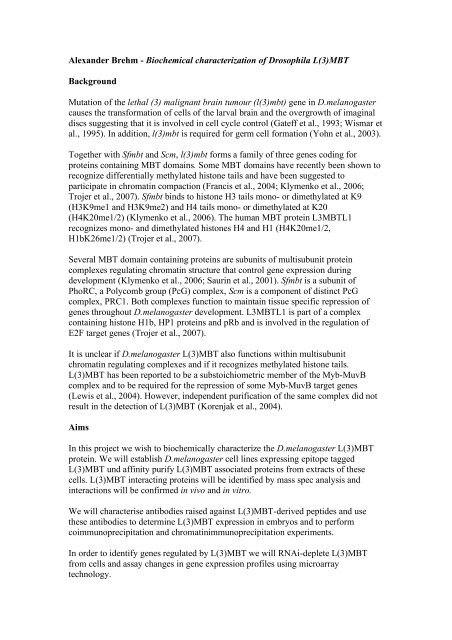
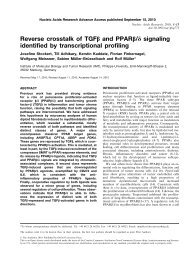


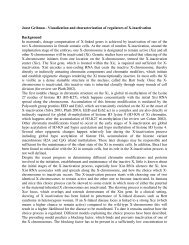
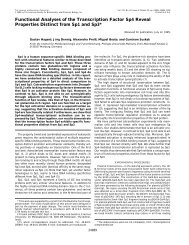
![2-(2-Bromophenyl)-3-{[4-(1-methyl-piperazine)amino]phenyl}](https://img.yumpu.com/22645635/1/190x248/2-2-bromophenyl-3-4-1-methyl-piperazineaminophenyl.jpg?quality=85)
